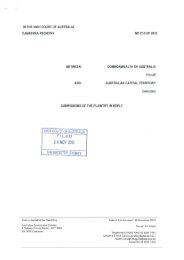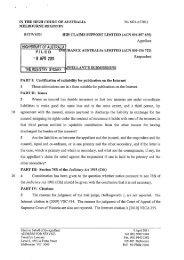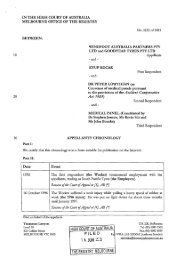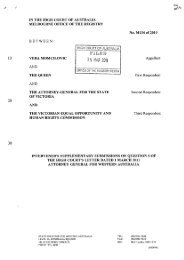Written submissions - High Court of Australia
Written submissions - High Court of Australia
Written submissions - High Court of Australia
Create successful ePaper yourself
Turn your PDF publications into a flip-book with our unique Google optimized e-Paper software.
15<br />
64. Likewise, the case for each <strong>of</strong> the accused differed. Again the three separate cases<br />
are summarized in the reasons <strong>of</strong> the <strong>Court</strong> below: CCA [159]-[161].<br />
65. Despite these differences, the trial judge confined himself to a narrative style summing<br />
up in relation to the facts. He did not ever distill for the jury the evidence and case<br />
relevant to each accused, and in particular the appellant. He did not ever direct the<br />
jury as to how they should apply, or link, his directions as to the law to the case and<br />
evidence against the individual accused.<br />
66. This error was compounded by the provision <strong>of</strong> the written redirection. Despite a<br />
question from the jury indicating a degree <strong>of</strong> uncertainty, and requesting an<br />
10 explanation, the written redirection made no attempt to link the legal directions back to<br />
the case and evidence relevant to the individual accused. Indeed, by providing the jury<br />
with a recast 'list' <strong>of</strong> the elements <strong>of</strong> each <strong>of</strong> potential heads <strong>of</strong> liability, the written<br />
redirections, if anything, encouraged the jury to reason in a general or abstract way,<br />
without any guidance as to how the cases <strong>of</strong> the individual accused should be<br />
approached.<br />
The Need to Distill, and Apply the Legal Directions to, the Case against each Accused<br />
67. A fundamental aspect <strong>of</strong> the task <strong>of</strong> the trial judge in summing up is to not only<br />
summarise the legal issues and the evidence, but also identify the real issues in the<br />
case and the facts relevant to those issues, and to provide an explanation as to how<br />
20 the law applies to those facts. 5 7<br />
68. It is not necessary for the trial judge to identify every piece <strong>of</strong> evidence or argument<br />
relevant to the accused.ss On the other hand, it is not sufficient for the trial judge to<br />
give a general exposition <strong>of</strong> the law, followed by a summary <strong>of</strong> the evidence in<br />
chronological form. There must be a collection or crystallization <strong>of</strong> the evidence<br />
relating to the various ingredients <strong>of</strong> the <strong>of</strong>fences in question, with a brief outline <strong>of</strong> the<br />
arguments relevant to that evidence. 5 9<br />
69. While the above is true <strong>of</strong> any summing up, it is particularly critical in the case <strong>of</strong> a trial<br />
<strong>of</strong> multiple accused where the evidence relevant to each is quite different, and raises<br />
quite different issues. A separate crystallization <strong>of</strong> the case against each accused is<br />
30 required.<br />
57<br />
Fingleton v The Queen (2005) 227 CLR 166 at 197 [47] per McHugh J; Alford v Magee (1952) 85 CLR 437 at<br />
466 per Dixon, Williams, Webb, lullagar and l
















